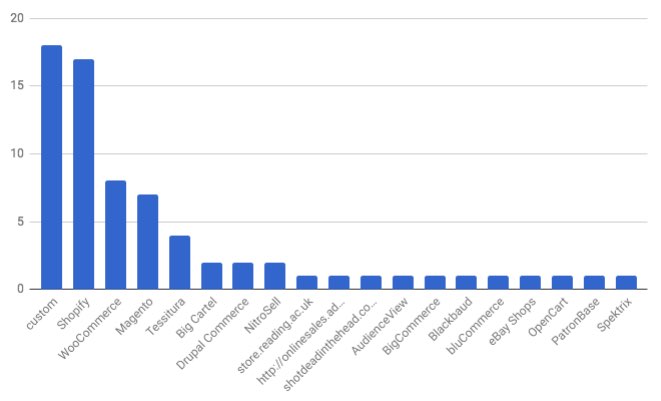“we’re very passionate about it, we’re strong on it”
If you worked on the digital side of the museum world I imagine you’d be pretty chuffed to hear a high-profile museum director publicly supporting this kind of work. Right?
But if you were following the reaction online over the past couple of days you’d have thought he’d suggested sacking the V&A’s (consistently award-winning) digital team, ripping out the building’s wifi, and deleting their entire online collection.
So what happened?
In case you’re not up to date on this one, Tristram Hunt is the recently-appointed director of the V&A (or a “novice museum worker” if you want to get all ‘not one of us’ about it, as several did). He recently gave an entertaining talk at the Hay Festival about the V&A’s history, then answered questions from the audience about acquisition policy, plywood, and using technology to make their collection more accessible.
His answer on the last topic was reported in The Times (Museum visitors seek refuge from digital world) before being increasingly misinterpreted:
I wouldn’t bother clicking any of those if you’ve not already read them, but keep the headlines in mind for later on.
Now, I got a C in GCSE History a couple of decades ago, so I’m fully aware of the benefits of going back to primary sources.
The Hay Festival website has a rather wonderful thing called Hay Player. Audio recordings of talks going back several years can be found there, and you can pay £1 to download one. A small price to pay.
Here’s where you can get a recording of Tristram Hunt’s speech and the Q&A that followed it. I highly recommend giving it a listen. The bit we’re interested in starts around the 54 minute mark.
I hope the good people at Hay don’t mind me reproducing the question and answer.
[Question from the audience] “You’ve talked about making the art more accessible for people in regional locations but you didn’t talk much about how technology can help you to do that. So I’m wondering if you have strategies around using the internet, social media, apps, etc to make things accessible.”
[Tristram Hunt] “Yes, this is a really strong and active area of debate. In one of our new galleries you can, on your iPhone, download your own personal guide to the contents of the galleries. And it’s done beautifully – there’s music, the curators talking… but you’re wandering around listening, either with your headphones or listening to your iPhone, whilst looking at the artefacts.
And actually it hasn’t proved that popular. There’s a sense of people often coming into the museum as a way to get away from digital activities. And what we’ll find is that they’ll then go home often and want to look at what they saw today, or they’ll be in the cafe looking at it, so they’ll reflect afterwards through digital media and digital access on what they saw, but in terms of their own personal interaction with the object, often they want to step back from that.
At the same time, what we’re involved in is a massive programme of digitising our collections. But again, it’s a debate. There’s a very big debate in the museum world about the Metropolitan Museum of Art and the amount of investment they put in to digitising their collection, which means that you’re taking it away from other areas.
And so we’re very passionate about it, we’re strong on it, but it’s rather like the newspapers – no-one’s got the answer yet about what you should do.
What I’m very passionate about is ensuring that we’re giving teachers the professional development and advice they need to be able to access our collections online to inform their teaching.
So if we pursue it though a more education-focused lens, that would be my ambition”.
[end]
That doesn’t sound so ridiculous, right?
To recap:
- He didn’t say he was about to “bin spending on digitising collections and creating apps, audio tours and other digital content, as he thinks the average museum punter isn’t interested in any of it”.
- He didn’t confuse digital collections with digital art. He didn’t even use the phrase ‘digital art’, and certainly didn’t say that anyone had been doing it all wrong.
- He didn’t say that “digitising museums is a waste of money”.
What he did say is that there’s a debate about how in-gallery technology might best be provided. I think that’s fair, and there are plenty of very interesting projects and experiments we could all point to that are exploring this area.
We might disagree with the assertion/assumption that people want to get away from interacting with digital technology in galleries, but there’s grounds for a debate (see the comments on the Times article). A more nuanced position is likely to be summed up by any or all of these:
- museums can be improved by in-gallery tech done well
- museums can be worsened by in-gallery tech done badly
- museums can work well without in-gallery tech
With a big fat ‘it depends on the circumstances’ bolted on.
Tristram uses the example of an audioguide in one of their galleries not being massively popular, and of course, we all know there are plenty of reasons why uptake of a particular thing might not be great. But you don’t even have to leave the building for an example of in-gallery audio technology being integral to the experience – see the current Pink Floyd exhibition that’s had rave reviews.
It’s also true that there’s a debate about the amount of museum resource that should be allocated to digitising collections. The particular merits of the Met Museum case can (and have been) debated too, but his key point seems fair enough to me. Museums don’t have bottomless reserves of cash and there’s a perfectly valid discussion to be had about how activity within a museum is prioritised.
So go back to those headlines again. How well do they line up with what was actually said? And where did some of those quotes comes from?
In the interests of transparency, I should mention that the V&A are one of my clients. I’ve never met Tristram Hunt though, and I didn’t speak to anyone there about this post before hitting ‘publish’.

